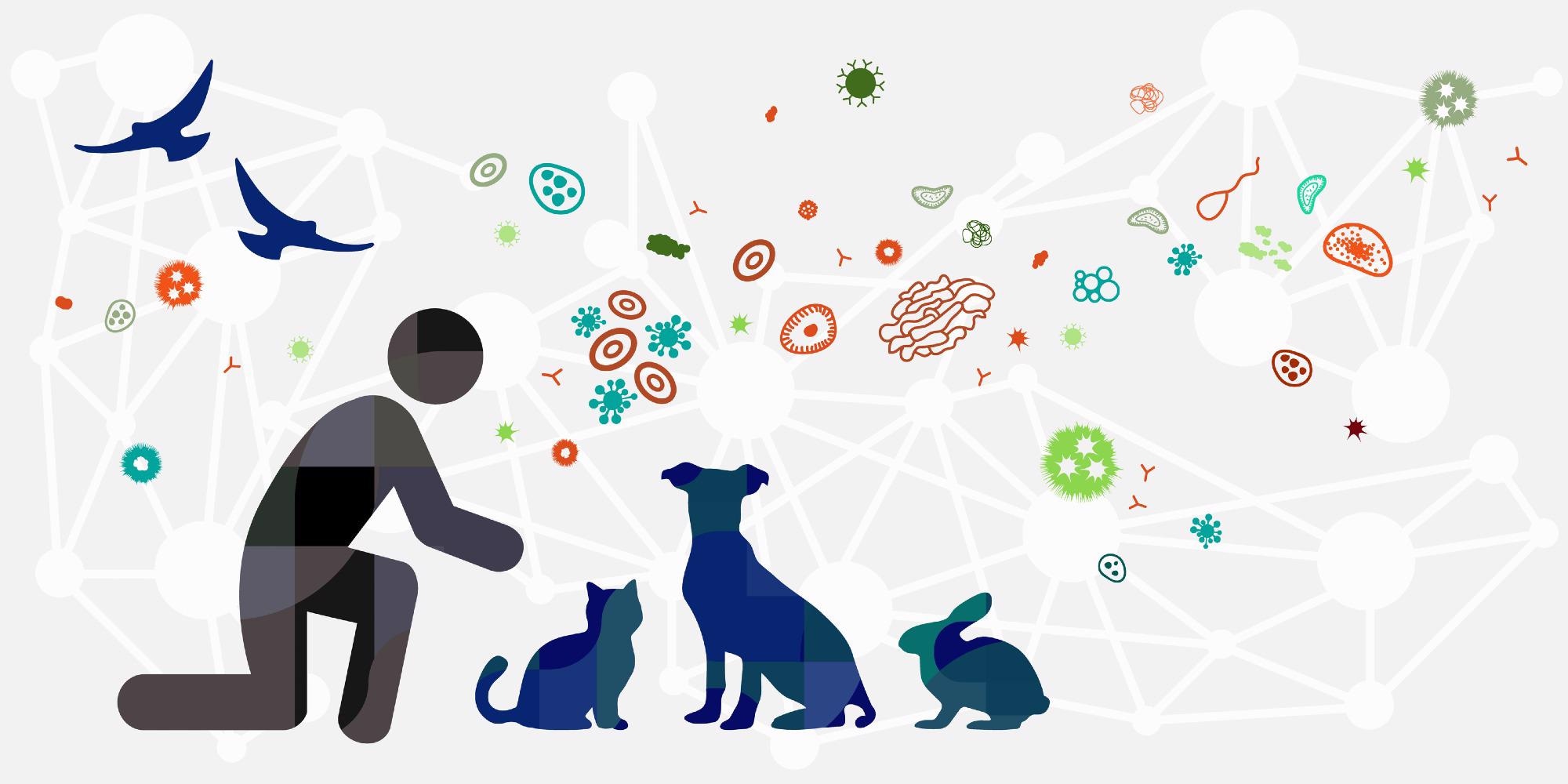- Introduction
- What are zoonoses?
- Is there a threat to global healthcare from zoonotic pathogens?
- Antibiotic resistance
- Global surveillance
- What can be done to better manage the threat of zoonoses?
- References
- Further Reading
Zoonotic pathogens present a major global health problem. Humans have close relations with domestic and agricultural animals, as well as those residing in the natural world.

Zoonotic diseases. Image Credit: magic pictures/Shutterstock.com
This article considers the nature of zoonotic pathogens and the risk associated with these micro-organisms for global healthcare. At the end of the discussion, we take a brief look at what is being done right now and what else can potentially be done to manage the threat.
What are zoonoses?
A zoonosis is an infectious disease that has jumped the animal to human species barrier. Zoonotic pathogens are either bacterial, viral, or parasitic. They spread to humans via food, water, or the environment. In some cases, certain diseases like HIV, for example, begin as zoonoses before subsequently mutating into human-only strains.
Zoonoses can cause recurring outbreaks of disease ––good examples being salmonellosis and Ebola virus. They are responsible for a significant proportion of newly identified infectious diseases, in addition to those we already know about. Zoonoses also lie behind some of the most high-profile and devastating epidemics and pandemics, for example, the coronavirus 2019 (COVID-19) pandemic caused by a recently emerged novel coronavirus known as severe acute respiratory syndrome coronavirus 2 (SARS-CoV-2).
Is there a threat to global healthcare from zoonotic pathogens?
Two major threats to global healthcare from zoonotic pathogens are the problem of antibiotic resistance and the challenges involved in surveillance for the emergence of these micro-organisms. We will first turn to the challenges posed by antibiotic use, before looking more closely at the issues involved with global surveillance.
Antibiotic resistance
The problem of antimicrobial resistance presents a challenge across global healthcare systems. The use of antibiotics in agricultural livestock is a widespread phenomenon and the practice exacerbates the potential for resistant strains of zoonotic pathogens to emerge. The problem of Clostridium difficile (C. difficile), more recently renamed Clostridioides difficile, is an excellent case in point.
C. difficile, the enteric pathogen responsible for some very unpleasant and often serious infections, routinely strikes fear into hospital personnel across the globe. This is due to the ease with which this pathogen can spread and thus its persistence and intractability of eradication. In this vein, endemic zoonoses may pose a greater and more insidious threat to human and animal health than pandemics.

Antibiotic resistance. Image Credit: Lightspring/Shutterstock.com
Global surveillance
Moving now to the issue of global surveillance, experts warn that the surveillance of zoonotic diseases needs to be urgently integrated into health security intelligence systems; indeed, this is a pressing issue in our globally connected world. It is only by doing so that we have any hope of effectively managing the emergence of future pandemics.
It is argued that zoonotic diseases pose the greatest health security threat to both human and animal populations. The problem is a global one affecting richer and poorer regions alike. We will first consider the problem posed in poorer areas, before turning our attention to the richer regions of the planet.
The problem of emerging zoonotic diseases is known to be especially acute in the remote rural regions of low and middle-income countries. Here especially, zoonotic disease surveillance has advanced considerably over the last couple of decades, though efforts tend to be concentrated toward urban and adjacent communities.
Remote and rural communities have a higher incidence of exposure to livestock and wild animals (as well as close contact with domestic animals). These communities also harbor endemic and neglected zoonotic diseases such as anthrax, rabies and bovine tuberculosis leading to billions of cases and millions of deaths each year. These poorer regions have restricted access to healthcare and far less support than urban communities when it comes to the management of emergent zoonoses.
Zoonotic diseases persist in these areas of the globe due to socioeconomic and environmental drivers, such as inequality and climate change. Lowered levels of surveillance in these areas cause delays in detection and response to disease outbreaks, thus increasing pandemic risk. This risk is much exacerbated due to latent amplification, travel, and animal trade.
The problem is not limited to poorer areas of the globe, however, and in high-income countries, domesticated, zoo and shelter animals present a potentially high-risk reservoir for zoonoses. Shelter animals especially are populations that present a much-elevated level of risk due to intrinsic stress experienced because of their unnatural living conditions and thus associated susceptibility to infectious pathogens.
What can be done to better manage the threat of zoonoses?
In the present day, the World Health Organization (WHO) works to prevent and manage zoonotic threats to public health using a multisectoral and coordinated approach toward the implementation of several measures including epidemiological and laboratory investigation and risk assessment and control.
And what about in the future? The devastating impact of the COVID-19 pandemic has spurred predictions that global investment in wildlife virology looks set to increase, this in addition to new surveillance programs that promise to identify hundreds of novel viruses with the potential to pose a threat to humans.
To aid the enormity of the task at hand, future scientists may increasingly turn to machine learning models ––zoonotic risk technologies ––to better understand zoonoses.
References and Further Reading
- Carlson, C., et al. 2021. The Future of Zoonotic Risk Prediction. Phil. Trans. Royal Society, B. Doi: 10.1098/rstb.2020.0358.
- Salyer, S. et al. 2017. Prioritizing Zoonoses for Global Health Capacity Building—Themes from One Health Zoonotic Disease Workshops in 7 Countries, 2014–2016. Emerging Infectious Diseases. Doi: 10.3201/eid2313.170418.
- Schnizlein, M. et al. 2022. Capturing the Environment of the Clostridioides difficile Infection Cycle. Nat Rev Gastroenterol Hepatol. Doi.org/10.1038/s41575-022-00610-0.
- The Royal Society of Medicine. 2021. Zoonotic Threats Must Be Integrated into Global Health Security Planning, Say Experts. Online: https://www.rsm.ac.uk/media-releases/2021/zoonotic-threats-must-be-integrated-into-global-health-security-planning-say-experts/.
- World Health Organization. 2020. Zoonoses. Online: https://www.who.int/news-room/fact-sheets/detail/zoonoses.
- Worsley-Tonks, K. 2022. Strengthening Global Health Security by Improving Disease Surveillance in Remote Rural Areas of Low-Income and Middle-Income Countries. The Lancet: Global Health. Doi: 10.1016/S2214-109X(22)00031-6.
Further Reading
- All Zoonosis Content
- Zoonosis – What is a Zoonosis?
- Zoonosis Carriers
- Zoonosis History
- Zoonosis Outbreaks
Last Updated: Jun 15, 2022

Written by
Dr. Nicola Williams
I’m currently working as a post-doctoral fellow in the History of Science at the Leeds and Humanities Research Institute (LAHRI), at the University of Leeds. Broadly speaking my research area falls within the remit of the history of biology and history of technology in the twentieth century. More specifically I have specialist knowledge in the areas of electron microscopy and cellular and molecular biology, women in science and visual culture.
Source: Read Full Article
